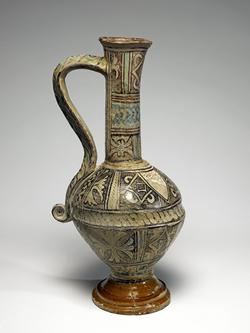Current Location: In storage
Maker(s)
Pottery:
Unidentified Orvieto pottery
(Probably)
Entities
Categories
Description
Late Medieval, maiolica ewer, painted in copper-green, turquoise-green and manganese with panels containing stylised foliage, rhomboids and knots, surrounded by cross-hatching and shields.
Pale buff earthenware, the foot lead-glazed yellowish-brown, the rest tin-glazed ivory; the glaze on the neck has a pock-marked surface and differs in colour from that on the body. Painted in copper-green, turquoise-green and manganese.
Shape15. Bulbous ovoid body with restriction round the widest part; moulded, solid pedestal foot; long slender neck, the rim pinched slightly at the front to form a lip; loop handle of triangular section, the lower end of which runs down the shoulder and terminates in an outward curling scroll.
On the restriction, there is a band of guilloche ornament. The rest of the body and neck are divided into panels containing manganese rhomboids, knots or stylised foliage, surrounded by cross-hatching, and, on the shoulder, two unblazoned shields. In the middle of the neck there is a turquoise-green chain. The handle is decorated with manganese ogee lines, each with a dab of green at its apex, and roughly drawn Vs on either side. Below the handle, there are narrow horizontal lines of alternate colours.
Notes
History note: Presumed excavated in Orvieto; Elia Volpi, Florence; Durlacher Brothers, London, from whom purchased in November 1920 by F. Leverton Harris.
Legal notes
F. Leverton Harris Bequest, 1926
Measurements and weight
Height: 38.0 cm
Width: 19.0 cm
Acquisition and important dates
Method of acquisition: Bequeathed
(1927-12)
by
Harris, F. Leverton, The Right Hon.
Dating
13th Century
14th Century
Medieval
Circa
1275
CE
-
1350
CE
Note
Ewers with very tall, narrow necks are uncommon in comparison with other late medieval forms from Orvieto and elsewhere in central Italy.
This ewer, or its components , were presumably excavated in Orvieto, as it can be seen, numbered 4, in the ninth of a group of photographs taken there c. 1909-10, which were given by David Whitehouse to the British Museum 's Department of Medieval and later Antiquities in 1986, together with a manuscript of Alessandro Imbert's 'Ceramiche orvietan dei secoli xiii e xiv' written in the hand of Prof. Percale Perali. The photograph is inscribed 'Volpi' near the jug, for the collector and dealer, Elia Volpi of Florence.
School or Style
maiolica arcaica
People, subjects and objects depicted
Components of the work
Decoration
composed of
high-temperature colours
( manganese and copper-green and turquoise-green)
Foot
composed of
lead-glaze
Diameter 11.5 cm
Body
Materials used in production
except foot
Tin-glaze
Earthenware
Techniques used in production
Tin-glazing
References and bibliographic entries
Related exhibitions
Identification numbers
Accession number: C.81-1927
Primary reference Number: 47271
Stable URI
Audit data
Created: Saturday 6 August 2011
Updated: Tuesday 30 April 2024
Last processed: Tuesday 2 September 2025
Associated departments & institutions
Owner or interested party:
The Fitzwilliam Museum
Associated department:
Applied Arts

 IIIF Manifest
IIIF Manifest






